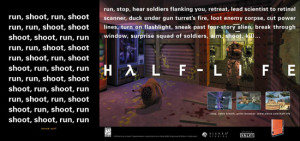It can be argued that the experience of a first person shooter is actually the act of being a sentient roaming gun. Though some 2nd Amendment debates would hold this is the case in reality, it could be more reasonably articulated that it is in many ways the case in games. On a technical level, often the player is just a bounding box with a weapon visible, perhaps some hands, and in multiplayer they are displayed as a character to other bounding boxes with a weapon visible. Metaphysically speaking, now that sounds fancy, the primary input with the game world in an FPS is simply shooting (particularly in the Quake franchise which centers its logic systems around damage or proximity) so obviously the gun at hand is a primary source of expression.
This however is greatly impacted by the inventory and spawning system of the game. In the Quake and Unreal franchises you spawn with a certain supply of weapons, and you find others in the environment. The weapons are expressions of discovery, what you have found, they represent exploration and knowledge. These weapons are also usually fairly distinct, sure they can be broken down by simply hitscan or projectiles, but no one is going to argue that Quake Live’s (and thus Quake 3’s) Plasma Gun and Rocket Launcher are particularly similar weapons. The weapons are intentionally as distinct as their location in a level and are designed to occupy a large range of design space within the scope of the mechanics. Continue reading

